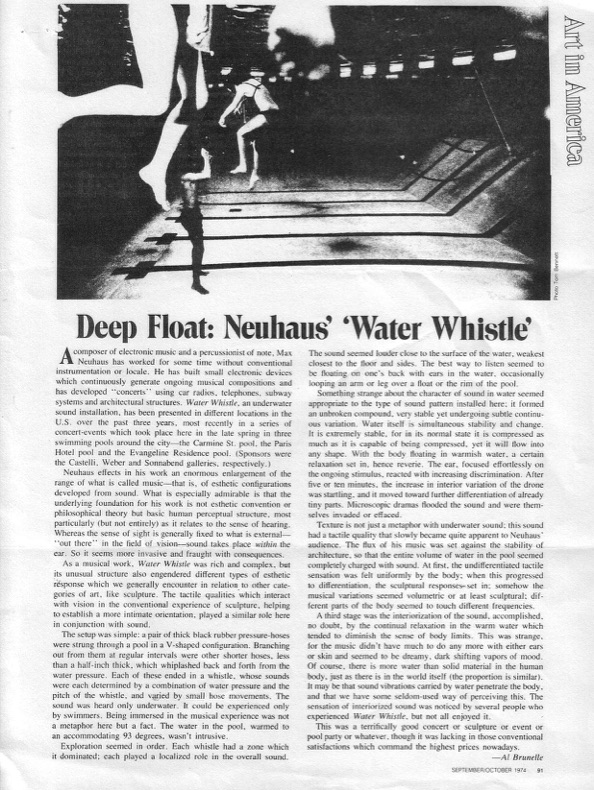1974

Art in America, September / October 1974
Al Brunelle
A composer of electronic music and a percussionist of note, Max Neuhaus has worked for some time without conventional instrumentation or locale. He has built small electronic devices which continuously generate ongoing musical compositions and has developed 'concerts' using car radios, telephones, subway systems and architectural structures. Water Whistle, an underwater sound installation, has been presented in different locations in the U. S. over the past three years, most recently in a series of concert-events which took place here in the late spring in three swimming pools around the city - the Carmine Street pool, the Paris Hotel pool and the Evangeline Residence pool. (Sponsors were the Castelli, Weber and Sonnabend galleries, respectively.)
Neuhaus effects in his work an enormous enlargement of the range of what is called music - that is, of esthetic onfigurations developed from sound. What is especially admirable is that the underlying foundation for his work is not esthetic convention or philosophical theory but basic human perceptual structure, most particularly (but not entirely) as it relates to the sense of hearing. Whereas the sense of sight is generally fixed to what is external - 'out there' in the field of vision - sound takes place within the ear. So it seems more invasive and fraught with consequences.
As a musical work, Water Whistle was rich and complex, but its unusual structure also engendered different types of esthetic response which we generally encounter in relation to other categories of art, like sculpture. The tactile qualities which interact with vision in the conventional experience of sculpture, helping to establish a more intimate orientation, played a similar role here in conjunction with sound.
The setup was simple: a pair of thick black rubber pressure-hoses were strung through a pool in a V-shaped configuration. Branching out from them at regular intervals were other shorter hoses, less than a half-inch thick, which whiplashed back and forth from the water pressure. Each of these ended in a whistle, whose sounds were each determined by a combination of water pressure and the pitch of the whistle, and varied by small hose movements. The sound was heard only underwater. It could be exprienced only by swimmers. Being immersed in the musical experience was not a metaphor here but a fact. The water in the pool, warmed to an accommodating 93 degrees, wasn't intrusive.
Exploration seemed in order. Each whistle had a zone which it dominated; each played a localized role in the overall sound. The sound seemed louder close to the surface of the water, weakest closest to the floor and sides. The best way to listen seemed to be floating on one's back with ears in the water, occasionally looping an arm or leg over a float or the rim of the pool.
Something strange about the character of sound in water seemed appropriate to the type of sound pattern installed here; it formed an unbroken compound, very stable yet undergoing subtle continuous variation. Water itself is simultaneous stability and change. It is extremely stable, for in its normal state it is compressed as much as it is capable of being compressed, yet it will flow into any shape. With the body flating in warmish water, a certain relaxation set in, hence reverie. The
ear, focussed effortlessly on the ongoing stimulus, reacted with increasing discrimination. After five or ten minutes, the increase in interior variation of the drone was startling, and it moved toward further differentiation of already tiny parts. Microscopic dramas flooded the sound and were themselves invaded or effaced.
Texture is not just a metaphor with underwater sound; this sound had a tactile quality that slowly became quite apparent to Neuhaus' audience. The flux of his music was set against the stability of architecture, so that the entire volume of water in the pool seemed compltely charged with sound. At first, the undifferentiated tactile sensation was felt uniformly by the body; when this progressed to differentiation, the sculptural responses set in; somehow the musical variations seemed volumetric or at least sculptural; different parts of the body seemed to touch different frequencies.
A third stage was the interiorization of the sound, accomplished, no doubt, by the continual relaxation in the warm water which tended to diminish the sense of body limits. This was strange, for the music didn't have much to do any more with either ears or skin and seemed to be dreamy, dark shifting vapors of mood. Of course, there is more water than solid material in the human body, just as there is in the world itself (the proportion is similar). It may be that sound vibrations carried by water penetrate the body, and that we have some seldom-used way of perceiving this. The sensation of interiorized sound was noticed by several people who experienced Water Whistle, but not all enjoyed it.
This was a terrifically good concert or sculpture or event or pool party or whatever, though it was lacking in those conventional satisfactions which command the highest prices nowadays.
Art in America, September / October 1974